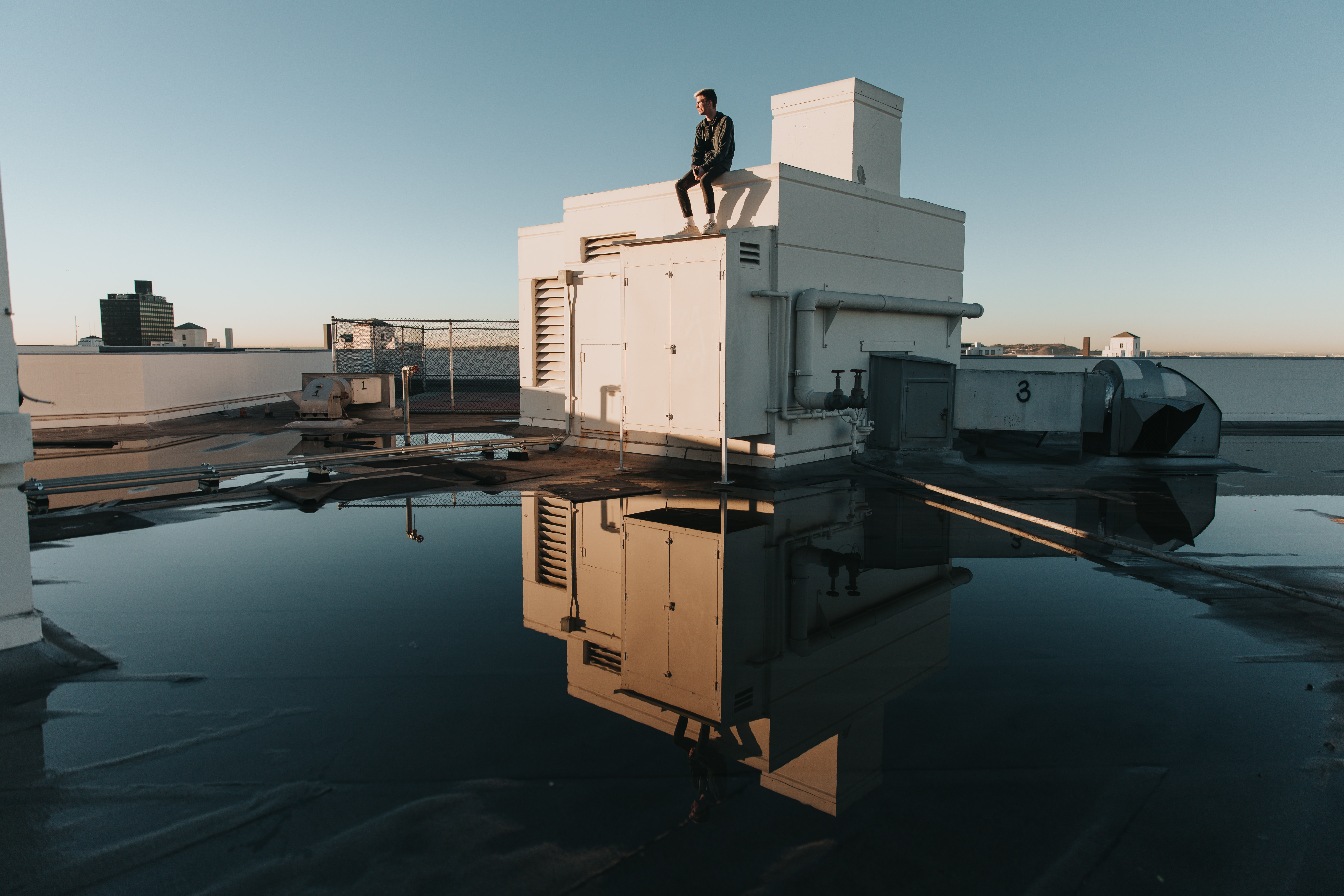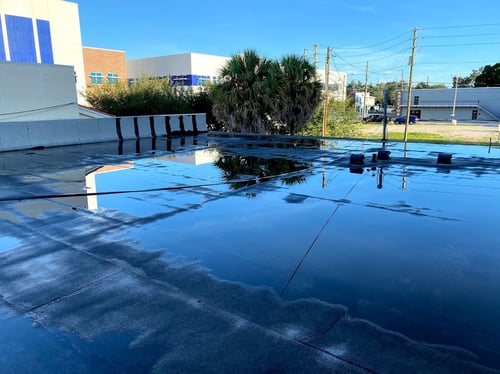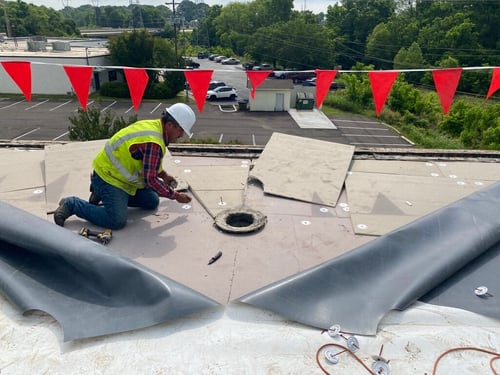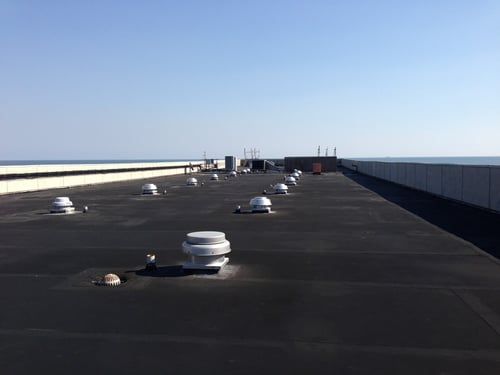What You Need to Know About Commercial Roof Water Ponding
February , 2023 | 6 min. read

It’s human nature to be drawn to water - we have been since the dawn of time. We fish in it, swim in it, bathe in it, and drink it. We even build our homes to be close to it; we love water. However, we hate water when we find it in places it’s not supposed to be. In the basement, spilled over on our laptops, and worst of all, seeping through our roofs. If you’ve ever dealt with water ponding (no, that’s not a cool new koi fish feature available to a roof near you), you know just how stressful this issue can become, and how quickly resulting damages can occur.
At RoofCrafters, we’ve been aiding business owners like you in water ponding relief efforts on their properties for nearly 30 years now, and we’ve just about seen it all. We know that if you let your ponding water situation linger for a little bit too long, your entire property will suffer the ill effects. We also know that if you catch it quickly enough, your roof can certainly be saved, and your building will thank you.
That being said, if you’re a commercial business owner and you believe that you’re suffering from ponding water on your roof and you’re not sure where to turn, we’re glad you’re here. In this article, you’ll learn why exactly ponding water is bad for your roof, what happens if you ignore it, how to fix it, how to prevent it in the future, and lastly, what your next steps should be. Let’s dive in! (Get it? Too soon?)
Is Ponding Water on My Roof Bad?
First and foremost, what’s ponding water? It’s simple: ponding water can be defined as water that remains on your roof for 48 hours or longer. So, if you’ve ever seen standing water on the roof of your building that seems to congregate in one area, it may not seem like a big deal. However, there is likely a lot of damage being done to your roof and your building the longer the water sits there. What’s likely to happen first is the deterioration of your roofing membrane, which rapidly decreases the lifespan of your roof.

Ponding water also causes commercial roofing systems to lose their elasticity, in turn becoming brittle. This creates a weakened roof that’s susceptible to the elements. Not to mention, once a roof loses its elasticity, its waterproofing capabilities are compromised, too. Once this happens, excess water can make its way into the structure of the roofing system, wreaking all sorts of havoc on your building, such as wet and damaged insulation.
At that point, you’ll be left with damage to the entire property, poor air quality, mildew, and mold. Routine maintenance is important in general, however, it’s especially important for commercial properties that are susceptible to water ponding. Be sure to schedule professional maintenance twice a year, folks!
What Happens If I Ignore Water Ponding on My Roof?
If you choose to ignore water ponding on your roof, many negative issues can occur as a result including:
- Stains: over time, ponding water will eventually discolor your roof if it’s left to sit long enough. Not only does this make your property less visually appealing, but it also can decrease its performance.
- Moss: if ponding water is neglected for a long period of time, vegetation such as moss, algae, and even grass will begin to form. This causes issues for your gutter systems and can clog drains as well. Not to mention, it looks pretty nasty.
- Pests: if vegetation growth wasn’t off-putting enough, water ponding invites pests such as mosquitos, carpenter ants, cockroaches, and even birds to make a home on your roof. Before you know it, they may even become tenants inside your property.
How Do I Fix Ponding Water on My Roof?
Depending on the type of roofing system you have, there are a few ways you can resolve water ponding. Firstly, you’ll need to get in touch with a professional roofing contractor to come to perform an inspection. They’ll likely go straight to your drainage system. Most drainage systems aren’t designed to handle an influx of water at one time, so if you’ve had a heavy rain recently, this could be the reason your drains are backed up.

Your roofer can help you to improve this problem by adding more drains to your roofing system and installing crickets between them. Your roofer may also add tapered roofing insulation to create a slope on your roof. This will allow more water to move toward the new or existing drains. They’ll also make sure your gutters are free of any debris that could be causing excess water to back up and remain stagnant on your roof.
How Do I Prevent Water From Ponding on My Roof?
As any good property owner or manager knows, the best way to keep your building in good working condition is through preventive measures. The same applies to your roof! There are several ways to reduce ponding water through prevention, and that starts with the roofing material itself. Adding a thicker or even additional layer to your roofing membrane in the areas that are prone to water ponding can help to increase the lifespan of your roof. Many commercial property owners will opt for a layer of reinforced polyester to the existing membrane, too. This will help strengthen the membrane while lessening the possibility of water penetrating through the system.
The color of your roof can make a difference, too. Let’s consider our elementary school color education for a moment, shall we? As you know, lighter colors reflect, and darker colors absorb. So, if you have an issue with water ponding, a white roof isn’t going to be your best option because they don’t retain heat. Darker color roofs do retain heat though, in turn helping excess water to evaporate quicker than a lighter color roof.

It’s important to consider the penetrations and seams on your roofing system as well. These areas on the roof are the weakest points in the entire system, so if water is left to sit around them for too long, deterioration will occur causing roof leaks and water damage inside of the building. Be mindful of the sensitive areas of your roof, and be sure to reinforce them as time goes on.
I Have Water Ponding on My Roof, What Now?
If you suspect you have water ponding on your roof, don’t panic! Contact a professional roofing contractor, and they’ll get you squared away. If you don’t, you know now what will happen if you ignore stagnant water. You also know how your roofer is most likely to resolve the issue, as well as the proper preventative measures to avoid water ponding in the future. As long as you're diligent and stay on top of the issue, take a deep breath, relax, and let the roofing experts handle it.
Your local roofing contractor will be able to aid you with any questions or concerns you may have about ponding water, and break down the restoration process for you so that you can better understand what’s in store. That being said, it’s important to acquire several different roofing estimates before choosing the company that’s the best fit for your roofing needs. If you’re struggling to find the best contractor for the job, be sure to download “The Top 10 Most Critical Questions You Want to Ask Your Potential Roofing Contractor”.
This checklist includes several different prompts to ask your roofer to prepare you to hold the company accountable for its quality of work and services when it comes to your upcoming project on your commercial business. In the meantime, continue learning about hiring the right contractor for the job by reading our article, “5 Reasons to Hire a Quality Commercial Roofing Contractor”
My name is Cassie, and I’m the Content Manager here at RoofCrafters. I was born and raised in Chicago, Illinois, and made my way out to Florida post-college graduation. I’m incredibly passionate about writing and creating valuable content that helps others with the collaboration of my marketing team. When I’m not working, I enjoy shopping (a little too much), spending time at the beach, and reading!




